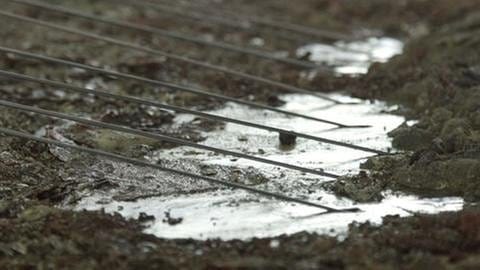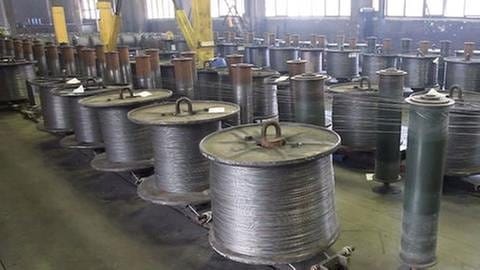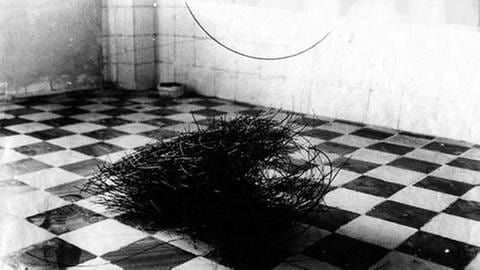Gesänge einer REDE - In den Stimmen des Materials
Klanginstallation von Thomas Schulz
Im Oktober wird die Umgebung des Fischhauses in dichter Bewachsung von Bäumen und Büschen stehen. Der Verlauf des Flusses bildet darin eine Schneise, eine Lichtung; über dessen Wasser spannt sich ein Stahldraht, der über eine Länge von 60 m den Raum zwischen Flusskreuzung und Fischhaus verbindet und durch die Lüftungsschlitze im Dach in dessen Inneres führt.
Die Bewegungen meiner Hand am Draht sind das Medium, das die im Flussbett erzeugten Klänge in den Schallraum des Fischhauses überträgt. Die akustischen Turbulenzen des Außen werden durch den Draht im Innenraum hörbar.
Draußen, im fürstlichen Park, ist das Klanggeschehen ein anderes, leiser, vermischter. Die Umgebungsgeräusche sprechen mit, schalten sich ein. Klänge als Akteure, akustische Finger, neutrales kleines Verhör.

"HIGH PERFORMANCE WIRE ROPE", Steine und Holz aus dem Park und schließlich das mitgebrachte Sicherheitsglas verwandeln das Fischhaus in ein trans-ambulantes Saiten-Instrument. Darin, im Turm und auf sechs Metern Höhe ein Gerüst, ein besteig- und bespielbarer Turm, die Schaltzentrale, die akustisches Arbeiten ermöglicht.
Am Dachgebälk befestigte Edelstahlseile halten einen Klang-Balken aus Fichtenholz. Dicht über dem Boden schwebend fallen seine scharf geschnittenen Kanten ins Auge. Der Blick nach oben erfasst drei "Gläserne Segel", aber auch die Unterseite eines "Klangstegs" der, bestehend aus drei Dielen, zwischen Gebälk und Turm befestigt ist und ein Manövrieren im Geschirr der "Audioellen Risskanten" ermöglicht.
Die materialen Bestandteile der akustischen Konstruktion im Fischhaus weisen je für sich in unterschiedliche Richtungen – nach Donaueschingen, Berlin, Rothenburg – zu beteiligten, befreundeten Kräften, zu Ingenieuren und Architekten: Die Maßgabe "Kein elektrischer Strom im Fischhaus" ermöglicht ein Anknüpfen an frühere ambulante Konstruktionen aus Stahldraht, jenseits einer elektronischen Klangerzeugung.

Die Suche nach hochwertigem Draht führte mich ins WDI Stahldraht-Werk in Rothenburg an der Saale. Die neuesten Entwicklungen auf dem Feld des Stahldrahts können nur als Erfahrung außerordentlicher Klangmysterien bezeichnet werden. Die damit verbundenen Materialversuche und die audiovisuellen Aufzeichnungen im Stahldraht-Werk haben die Form einer Video-Dokumentation angenommen – ein "Portrait Draht", das die klingende Güte des Stahls aufnimmt und einen elektronischen Gegenpol zum elektro-stromlosen Geschehen im Fischhaus bildet. In Phasen der Nicht-Bespielung des Fischhauses verweisen Geräuschfelder aus dem Stahlwerk (beispielsweise den An- und Abklingbecken) auf andere Seinszustände der stählernen Klangkörper.
Ein Raum im Museum Biedermann in Donaueschingen ist als Aufführungsort für die akustisch- visuelle Annäherung bestimmt. Zu den Klängen von Durch die Raum fällt zeichnen Momente aus der Stahldrahtproduktion das akustische Gerüst, das ungehörte Lautstrecken, Szenarien unbekannter Distanzen und sinfonische Dissonanzen einer namenlosen Musik erklingen lässt.
Through which space is falling.
English
Through Which Space Is Falling
Songs of SPEECH – In the Voices of the Material
In October, the environs of the Fischhaus will be surrounded by densely-packed trees and bushes. The course of the river cuts a swathe through it, a clearing; there will be barbed wire stretched across the water, connecting the space between the river crossing and the Fischhaus across a distance of 60m and leading into its interior through the ventilation slots in the roof.

The movements of my hand on the wire are the medium that transfers the sounds produced in the riverbed to the acoustic space of the Fischhaus. The acoustic turbulences of the exterior become audible in the interior through the wire.
Outside, in the princely park, the sonic events are different – quieter, more mixed. The environmental sounds speak too, join in. Sounds as actors, acoustic fingers, a neutral little interrogation.
"HIGH PERFORMANCE WIRE ROPE", stones and wood from the park and finally the security glass brought along transform the Fischhaus into a trans-ambulant string instrument. Inside, in the tower and six metres up, a scaffold, a climbable and playable tower, the control centre that enables acoustic work.
Stainless steel ropes fastened to the roof beams hold a sound beam made of spruce wood. Floating only a little above the ground, its sharply-cut edges are conspicuous. A look upwards finds three 'glass sails', but also the underside of a 'sound bridge' fastened between the beams and the tower, consisting of three planks, which enables manoeuvring in the harnesses of the "audial crack edges".
Each of the material components of the acoustic construction in the Fischhaus point in different directions – to Donaueschingen, Berlin, Rothenburg – to involved, friendly forces, to engineers and architects: the stipulation "No electric current at the Fischhaus" makes it possible to follow on from earlier walkable steel wire constructions, beyond electronic sound production.

The search for high-quality wire led me to the WDI steel wire works in Rothenburg an der Saale. The latest developments in the field of steel wire can only be described as an experience of extraordinary sonic mysteries. The accompanying experiments on material and audiovisual recordings in the steel wire works took on the form of a video documentary – a "portrait of wire" that records the sounding quality of the steel and forms an electronic antipole to the electro-unelectric events in the Fischhaus. In phases where no sounds are being made at the Fischhaus, noise fields from the steelworks (for example the fuel heating and cooling installations) point to other states of being in the steel sound bodies.
One room at the Museum Biedermann in Donaueschingen has been chosen as a performance space for the acoustic-visual encounter. For the sounds of Durch die Raum fällt, moments from the steel wire production sketch the acoustic frame, which allows unheard sequences of sounds, scenarios of unknown distances and symphonic dissonances of a nameless music to sound.
Through which space is falling.
- Festivaljahrgänge
- Donaueschinger Musiktage 2015
- Themen in diesem Beitrag
- Thomas Schulz, Durch welches / Through which. Videofilm
- Verwandte Beiträge
- Werke des Jahres 2000: Bericht über "Contract Tendencies", Werke des Jahres 2004: Thomas Schulz' "The European Sculture - Neuropäisch", Klanginstallationen: Mehr als klingende Gartenzwerge der Neuen Musik, Roundtable: Klangkunst und Komposition – Die Gartenzwerge sind gewachsen, Boris Borowski, Orm Finnendahls/ensemble mosaik, Mario Verandi und Thomas Schulz, Klanginstallationen von Schulz, Orts, Verandi und de Vega